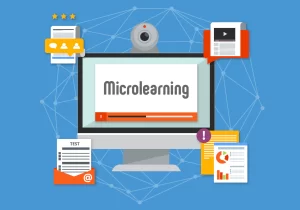
Top 10 Types of Microlearning
Microlearning gives employees the information they need, when and where they need it most. It’s like having a pocket-sized mentor, ready to provide quick and accessible learning whenever employees encounter a challenge or seek to expand their skills. But what exactly are the different types of microlearning that you can utilize to meet your training goals for Skilled Trades employees? Let’s dive into the top 10 types of microlearning designed specifically for the skilled trades industry.
Video Tutorials:
From welding techniques to precision shaft alignment, video tutorials provide visual step-by-step guidance for mastering various skills. With short, focused videos, tradespeople can learn at their own pace and revisit challenging concepts as needed.
Interactive Simulations:
Simulations allow tradespeople to practice their skills in a virtual environment, honing their craft without the risk of real-world mistakes. Whether it’s simulating electrical wiring or hydraulic circuits, interactive simulations provide hands-on experience in a safe and controlled setting.
Quick Quizzes:
Quizzes are a fun and effective way to reinforce learning and test knowledge retention. Tradespeople can brush up on safety protocols, code compliance, and equipment operation through engaging quizzes that keep them motivated and engaged.
Infographics and Cheat Sheets:
Visual aids such as infographics and cheat sheets offer quick reference guides for common tasks and procedures. Whether it’s a guide to tool maintenance or a diagram of construction blueprints, visual aids help tradespeople access essential information on the job site.
Mobile Apps:
With the rise of mobile technology, tradespeople can access microlearning materials anytime, anywhere, using their smartphones or tablets. Mobile apps offer on-the-go access to training materials, allowing tradespeople to learn during downtime or between jobs.
Audio Lessons:
For tradespeople on the move, audio lessons provide a convenient way to learn while commuting or working on-site. Whether it’s listening to safety tips or industry updates, audio lessons offer flexibility and accessibility for busy tradespeople.
Gamified Learning:
Gamification adds an element of fun and competition to microlearning, motivating tradespeople to engage with training materials and earn rewards for completing tasks. Whether it’s earning badges for mastering skills or competing on leaderboards, gamified learning keeps tradespeople motivated and engaged.
Case Studies:
Real-world case studies offer practical insights and solutions to common challenges faced by tradespeople. By examining real-life scenarios and problem-solving techniques, tradespeople can learn valuable lessons that can be applied directly to their work.
Peer-to-Peer Learning Networks:
Peer-to-peer learning networks provide opportunities for tradespeople to share knowledge, exchange tips, and support each other’s learning journey. Whether it’s participating in online forums or attending networking events, peer-to-peer learning fosters collaboration and community among tradespeople.
On-the-Job Training Modules:
On-the-job training modules offer hands-on experience and mentorship opportunities for tradespeople to learn from seasoned professionals. Whether it’s shadowing a master tradesperson or participating in apprenticeship programs, on-the-job training provides invaluable learning experiences that can’t be replicated in a classroom.
Final Thoughts
Microlearning is revolutionizing skill development in the skilled trades industry, offering flexibility, accessibility, and engagement. Whether it’s through video tutorials, interactive simulations, or gamified learning, microlearning equips tradespeople with the tools they need to succeed in a rapidly changing environment. Ready to elevate your team’s skills? Explore microlearning options today and watch your workforce thrive. Visit https://xlr8edlearning.ca/ to discover how microlearning can accelerate your team’s growth in the skilled trades.



